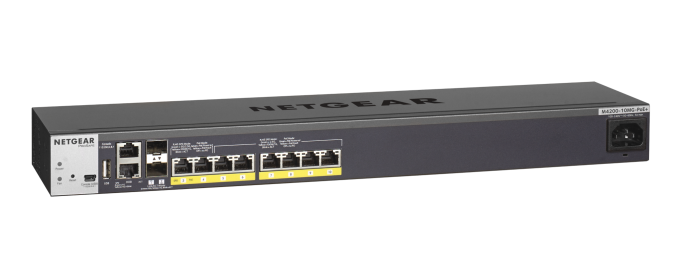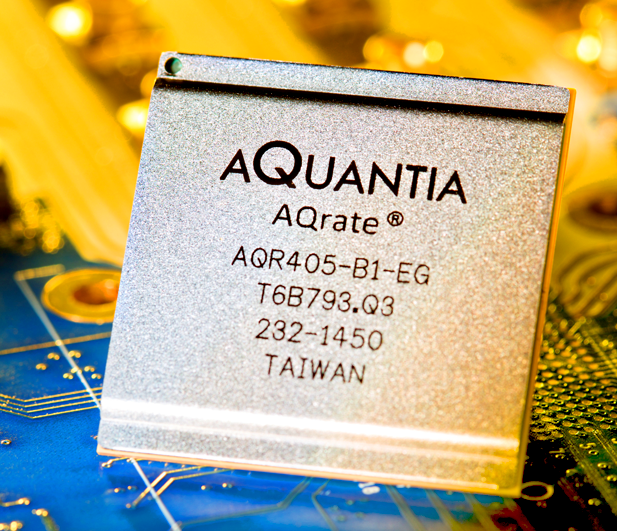NBASE-T Alliance Receives Boost with IEEE P802.3bz Approval for 2.5G/5G Ethernet
by Ganesh T S on October 3, 2016 8:00 AM EST- Posted in
- Networking
- 10GBase-T
- NBASE-T

Wired networks relying on traditional Cat 5e and Cat 6 cables (at their maximum channel length of 100m) have been limited to 1 Gbps so far. At the other end of the spectrum, 10 Gbps required augmented cables (Cat 6A or better) for transmission lengths typical in enterprise and business scenarios. Despite 10 Gbps Ethernet having been around for more than 10 years now, cost and power consumption aspects have limited its adoption on a wider basis. The NBASE-T Alliance was created to bring in support for speeds between 1 and 10 Gbps, while retaining the use of existing cabling infrastructure.
NBASE-T has become popular because it can act as an effective wired backhaul for 802.11ac wireless access points. With theoretical speeds exceeding 1 Gbps, the time and environment are right for technology that can replace the existing 1 Gbps network ports. 10GBASE-T is not really an effective solution because of the cost as well as power requirements aspect. Almost all enterprise access points are powered using Power over Ethernet (PoE). The IEEE 802.3af-2003 standard allows for up to 15.4 W (12.95 W assured), while PoE+ (IEEE 802.3at-2009) can provide up to 25.5 W. However, the 10GBASE-T standard doesn't currently support Power over Ethernet, even though it is being considered. Therefore, 10GBASE-T has not turned out to be an effective and universal solution to this challenge despite the bandwidth availability. This is where the 2.5 Gbps and 5 Gbps options provided by NBASE-T equipment become attractive. Some NBASE-T switches already implement PoE / PoE+, and are effective solutions for driving compatible 802.11ac wireless access points.
Netgear's M4200-10MG-PoE+ Managed Intelligent Edge Series Switch with 5G/2.5G Switching for High-Speed Wave 2 802.11ac Deployments
On September 23, 2016, the IEEE P 802.3bz 2.4G/5GBASE-T Task Force (which started work in March 2015) ratified the IEEE P802.3bz Standard for Ethernet Amendment: Media Access Control Parameters, Physical Layers and Management Parameters for 2.5 Gb/s and 5 Gb/s Operation. It allows 2.5 Gbps operation over standard Cat 5e cables, 5 Gbps over Cat 6, and 5 Gbps over Cat 5e under select conditions. All of these are up to at least 100m channel lengths.
The AQrate Family of NBASE-T PHYs from AQUANTIA - One of the Leading Market Players
The ratification is a big boost for the NBASE-T Alliance. The standardization also lends more credence to the NBASE-T plugfests scheduled to be conducted in October 2016. It will also bring more 2.5G/5GBASE-T products into the market, bring prices down and drive up adoption. The most important aspect is that the existing cabling infrastructure doesn't need a overhaul. This makes it very attractive for business and enterprise users.
From a power user / enthusiast viewpoint, NBASE-T equipment will be a good upgrade. However, readers planning on wiring up their homes would do well to go with Cat 6a cables for future-proofing purposes. 10GBASE-T products (both switches and motherboards / PCIe cards) for enthusiasts are already in the market, thanks to vendors like Asus. NBASE-T adoption will mainly be dictated by business and enterprise users in the near future. As local bandwidth requirements increase in the premises of the average consumer, 2.5G/5GBASE-T will surely find its way into networking gear for traditional consumers also.
Source: NBASE-T Alliance












37 Comments
View All Comments
azazel1024 - Tuesday, October 4, 2016 - link
As mentioned down the comments some, the smartest way to do it is likely running Cat6 and fiber next to each other. If you are getting the fiber in bulk, the price is actually pretty comparable between Cat6+fiber compared to just running Cat6a.I agree it doesn't make a lot of sense to skimp on new construction, but a lot of wiring jobs are for existing construction. Example my current house. I am not paying an electrician either, so it isn't like the difference between a $2k job and a $2.5k job. When I priced it out, for all of the drops all around my house it is the difference between a $200 job and a $500 job...plus the $200 job got done in about 1/2 or less of the time as the $500 job (because terminating Cat6a is a MUCH bigger pain in the butt than Cat6, same with running it).
I can always pull the wiring back out and re-run Cat6a if it every becomes absolutely vital.
It is possible some future standard is going to require Cat6a to be able to run in a residential setting, but what is currently on the books or near future is
1GbE and 2.5GbE 100 meters on Cat5e and better
5GbE 100 meters on Cat6 (not sure of length on 5e, but at a guess, 60-80 meters)
10GbE 45 meters on 5e, 55 meters on 6, 100 meters on Cat6a
Proposed 25GbE 10 meters on Cat6a (not enough to cover a house)
40GbE Cat7a to I think 10 meters
I'd guess the proposed 25GbE might be able to manage more than 10 meters on Cat7a, but a lot of it is simply how high frequency you need to get. To fit in an RJ45, the wire gauge can only be so large and even if you suppress noise to zero, receivers are only so sensitive and you can only transmit at so high a frequency (distortion and power use, plus higher cross talk).
Yes, as electronics improve, the transmitters are lower distortion, the receivers are more sensitive, etc.
That said, copper has its limitations and with the RJ45 standard you are never likely to see 100GbE on Cat 8 running 100 meters or anything like that. You might see 25GbE some day running on something like Cat7a, 8 whatever being able to run 30, 40 meters. You are also going to be running fire hoses of cabling and spending 20 minutes terminating each one and all of the individual shielded wires.
You get to a point where fiber is just much easier to run, service and terminate. You could have 100Gbps running on a copper patch cable a meter from your fiber media converter to the back of your desktop easily.
Communism - Monday, October 3, 2016 - link
You should be running Cat 8 cable at this point (Class I for Cat 6a compatibility or Class II for Cat 7a compatibility)You're going to need Cat 8 to exceed 100 GbE @ 100m.
BrokenCrayons - Monday, October 3, 2016 - link
Psha, mere Category 8 twisted pair wiring isn't forward looking AT ALL. I'm going straight for #6 gauge wire they use on 3-phase high-voltage power lines in order to future-proof! It should be good for 100 TbE and handle that 1.21 jigawatts I need to travel through time.willis936 - Monday, October 3, 2016 - link
Or, you know, a bundle of single mode fiber.BrokenCrayons - Tuesday, October 4, 2016 - link
And how is single mode fiber going to carry lightning from the top of the tower so that I can go back to the future, Doc? >.< We need PoE or the DeLorean's flux capacitor won't work!cm2187 - Monday, October 3, 2016 - link
At 10Gbit, we are getting close to speeds at which data goes in and out of RAM within a PC. And that speed isn't progressing much anymore. So I don't think it's absurd to assume that we probably won't have any use for 100Gbit in a home. There is just nothing that can consume it. And unless you have 4K CCTV in every corner of every room (not sure I'd like to live in that flat...), I don't see how IoT will consume that either.zepi - Monday, October 3, 2016 - link
10Gb is nowhere near of modern memory speeds. Dual channel ddr4 3000 sticks can reach somewhere around 40GB/s, so rougly 30 times more than 10Gbps network interfaces...zodiacfml - Thursday, October 6, 2016 - link
The physical link is not for a single client which is the reason for these high speed standards.DanNeely - Monday, October 3, 2016 - link
What's the deal with 10GBASE-T not supporting POE?zepi - Monday, October 3, 2016 - link
Probably the relatively high current and the fluctuations of it cause interference to the data signals, which are already very difficult to get running in less noisy environments, not to mention the additional noise caused by power delivery.